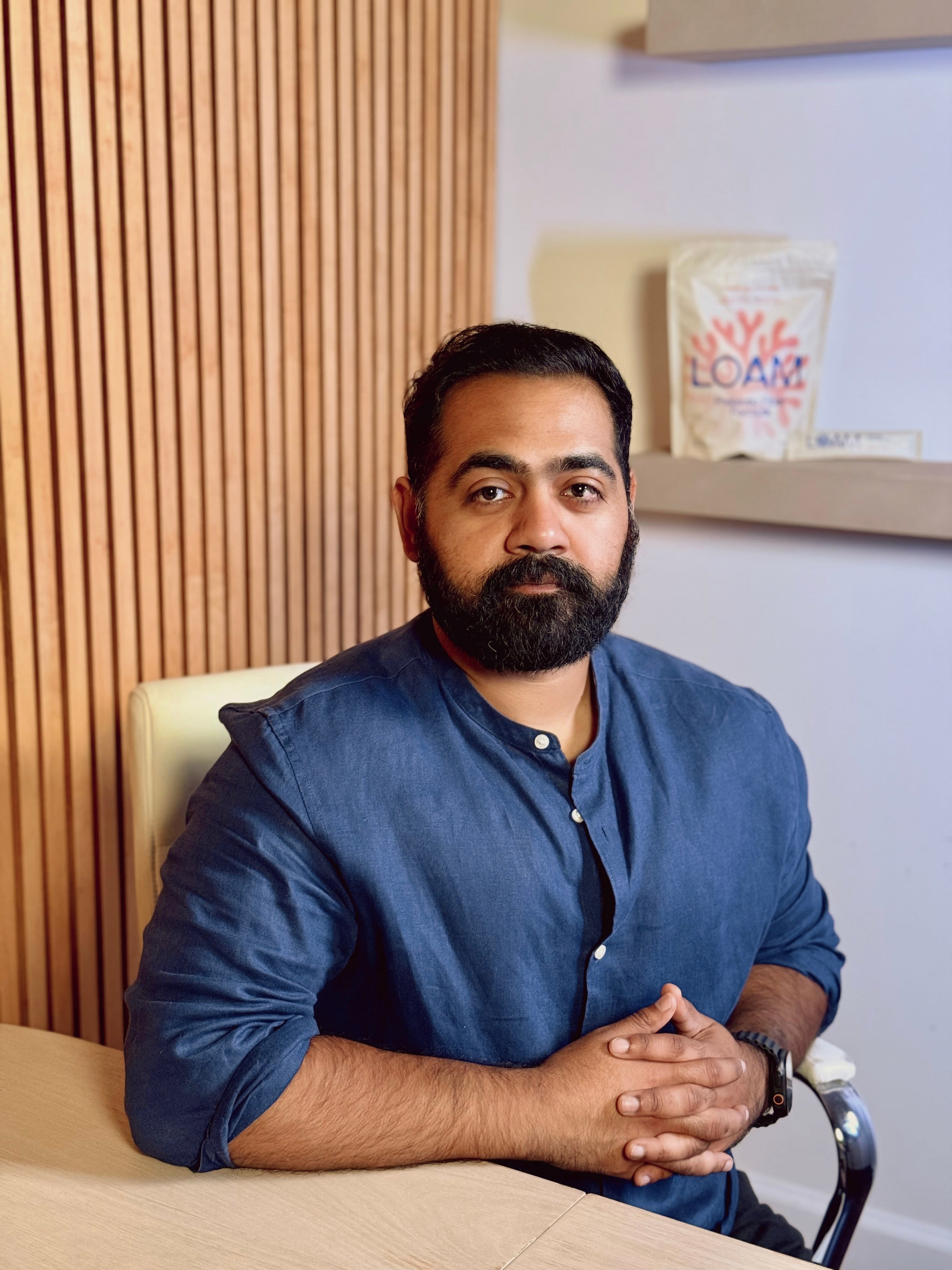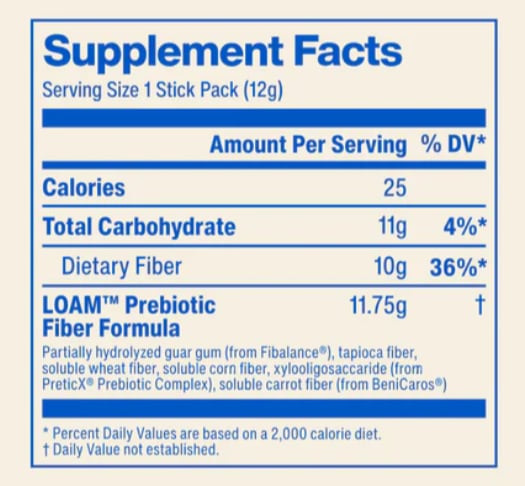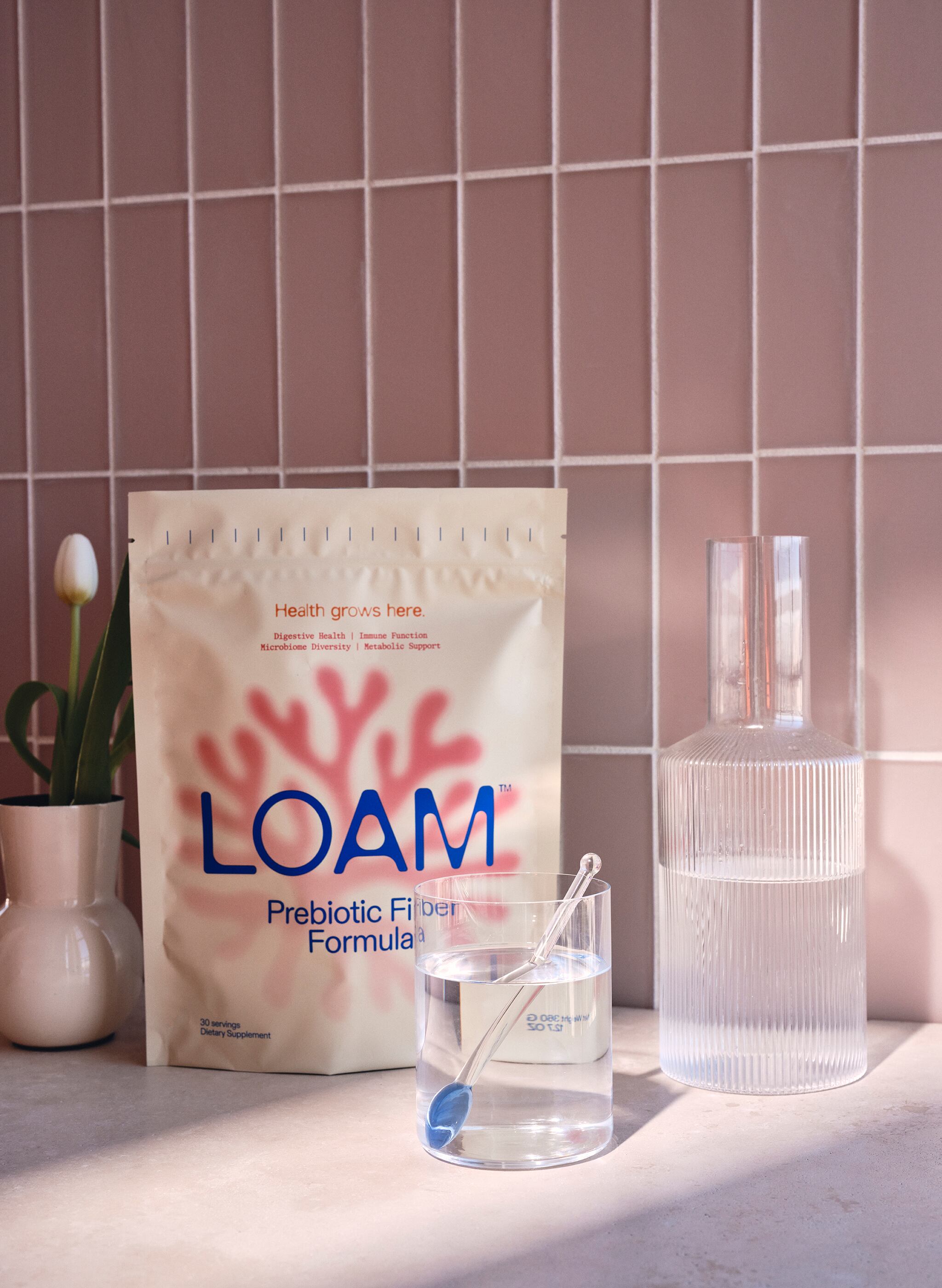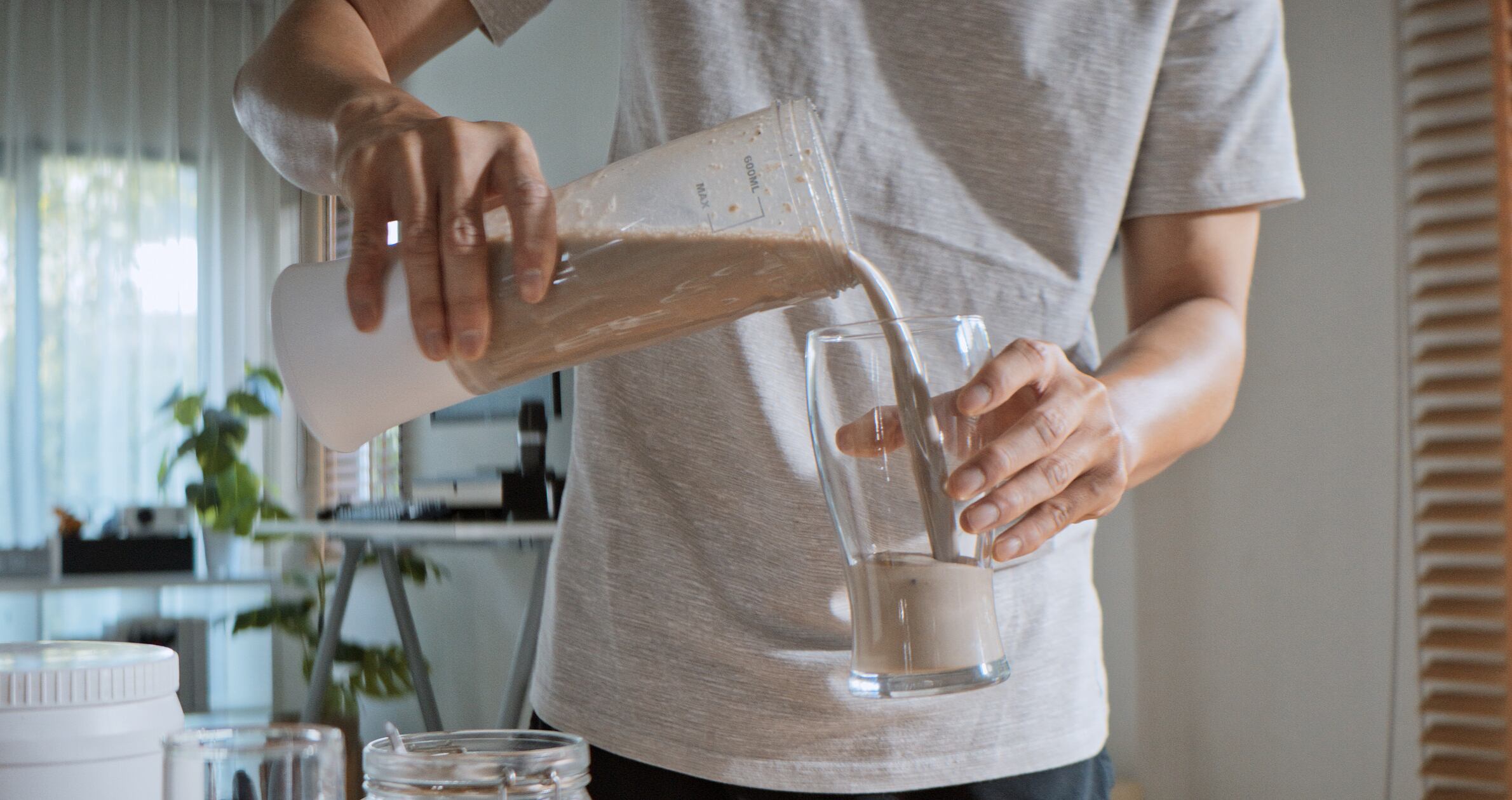Around 95% of American adults do not consume enough fiber through diet alone, with similar figures observed in European countries, such as the UK. As an NHS surgeon, Dr. Karan Rajan has seen the impact of low fiber diets firsthand and launched Loam as a direct response to the problem.
After spending close to $20,000 on fiber supplement samples, Dr. Rajan discovered most offered a poor user experience. They were typically viscous, had an unpleasant flavor or only offered one type of fiber at a relatively low dose.
Loam aims to fill this gap in the market—a high fiber, tasteless and odorless supplement that dissolves completely in water, formulated with six soluble prebiotics to mimic dietary diversity.
Taking to social media, Dr. Rajan took his 10 million followers along the brand-building journey, providing educational content on why fiber is not only vital to gut health but also to overall well-being.
Here, he explains how he built the brand and the product, and how Loam not only challenges conventional fiber supplements but also the stereotype that traditional doctors do not understand the gut microbiome.

NI+: What is Loam and what differentiates it from other fiber products on the market?
KR: In one line, Loam is a multi-prebiotic fiber blend. While there are other prebiotic fiber products on the market, Loam captures something which doesn’t already exist.
Traditional fibers on the market either feel chalky or gritty, or they are very viscous, like psyllium husk. With these traditional fibers, the solubility is quite poor, and that’s pretty much the case for every single fiber supplement out there. The user experience isn’t great—fiber supplements often feel like a chore or something people feel they have to take—it’s not enjoyable.
Loam is highly soluble and goes completely clear when it’s dissolved in water. This means people don’t have to forge a new routine but can seamlessly integrate Loam into their life. They can add it to essentially any food or beverage, and it dissolves with the highest solubility you can achieve and with no odor or textural mouthfeel.
We have also purposefully formulated Loam so that it has no flavor. While flavored supplements may taste great for a few days or weeks, people get bored of the same flavor and then stop—it doesn’t become a routine or a ritual in their life.
NI+: Which prebiotic fibers did you include in the formulation and why?
KR: Loam mimics dietary diversity with six prebiotic fibers: carrot fiber, soluble corn fiber, wheat fiber—which is non-GMO and gluten free—xylo-oligosaccharides, cassava fiber and partially hydrolyzed guar gum. From our research, we discovered that six fibers is the sweet spot. If you have too many fiber strains, then their individual dosing is virtually non-existent, whereas if you have too few, you lose the diversity of fibers.
We wanted to make sure that we had enough medium and slow fermenting fibers which can make it all the way to the end of the colon where most bacteria live, particularly butyrate producers. This differentiates it from traditional fiber supplements which have fast fermenting fibers, like inulin or fructo- oligosaccharides or pectin, which ferment in the early part of the colon and can exacerbate bloating.

In addition, most supplements, even the leading products on the market, have a fiber serving size of around 4 to 6 grams, but Loam is dosed at 10 grams per serving.
NI+: What scientific evidence backs the product?
KR: Loam has a great evidence base behind it. Each of the six ingredients have dozens of clinical trials which back up the veracity of the product’s claims. It contains high quality, low FODMAP prebiotics, with strong scientific evidence behind each.
We haven’t formally announced it yet, but we are currently conducting a clinical trial on Loam. It’s a large, randomized, placebo-controlled trial with around 90 participants, with three arms and dose escalation. This will help differentiate us further, as while some supplements have clinical evidence to back up individual ingredients, few test the product as a whole.
We are also about to announce a partnership with a wearable company which is involved in the study. I can’t reveal too much yet, but it’s something we’re very excited about.
NI+: How did you build the brand and the product?
KR: When I first began my research, I started ordering fiber supplement samples to assess the quality of the market offering. I spent around $20,000 on samples to test them, look at branding and see how they compared. I reached out to suppliers in India, China, the US, Canada, Russia and Singapore—all over the world—which was very expensive, but it gave us a really good overview of where the gaps were in the market.
When we decided on the final formulation, we started reaching out to manufacturers in the US. We had some good contacts there and wanted to ensure we had personal relationships with everyone in our supply chain. Being on this side of the fence is a whole new world; as a start-up that is hoping to scale quickly, there are very few manufacturers who will give you good terms and be willing to take a gamble. We found someone who was willing to do that, and we are very grateful to them.
NI+: How much does the product cost? And what regions are you launching in?
KR: We’ve got two different versions of the product—a 30-day stick pack and a gusseted pouch of powder. If you sign up for a monthly subscription, the powder is $45 a month and the stick pack is $54 a month. That’s just $1.50 and $1.80 per serving, respectively.
Compared to other products on the market, it’s very accessible. Loam is cheaper than the leading US and UK prebiotic supplements, and it’s backed by good science, good branding and a good user experience. We bought the cost down as much as possible as we really wanted to target the mass market. We want this in people’s hands, and we don’t want to be viewed as a prestigious product that only few can afford. Everyone needs fiber, and we want everyone to be able to access it.
While we have made every effort to try and help microbiomes globally, there are certain countries where it’s difficult for a small team to figure out the specific licenses that you need. So, at the moment, we are launching in the US, Canada and the UK, with hopes of launching in other European countries and Australia and New Zealand. Basically, we’re essentially covering 90% of the geographies on our waitlist. We haven’t had any discussions with retail yet, but it’s a direction I think we’re heading in.
NI+: How important is gut health to overall health and how did your interest in gut health begin?
KR: Fiber is about more than just poop, it’s closely linked with immune health, brain health, metabolic health, cholesterol, blood sugar and energy levels. In the clinics I’ve done over the years, I’d often recommend fiber supplements to patients, but in my view, there were never any good options. There were some that did a good job of bulking stool, but they didn’t go beyond that.
There is also a significant issue in that many doctors do not have the time to talk about the gut microbiome with their patients. Specialists like GI surgeons and gastroenterologists are so time poor that they just don’t have the time to speak to patients about their gut health in depth, so there’s a lot of education that needs to be done here.
In the clinical trials we’re doing, we’re trying to showcase some secondary and exploratory outcomes, like gut brain connections, gut hormone connections, appetite, satiety, weight and cholesterol. We’re really pushing this forward because we want to showcase that fiber intake is closely related to full body health.
NI+: Did the gut microbiome feature in your medical training? And do you think healthcare professionals generally accept the importance of the gut microbiome for overall health?
KR: A friend of mine who is a doctor always jokes around saying that everyone is using the gut microbiome as an excuse for everything. For me, this highlights that traditional doctors don’t really understand the microbiome.
We’re learning more about the microbiome every single day. There’s more research coming out all the time, but its legitimacy is still questioned by a lot of mainstream doctors. We’re learning about the overlaps with women’s health conditions, like gut dysbiosis in menopause and endometriosis, and how the gut microbiome may be a causative factor in many other conditions.
In my view, if we unlock the microbiome, we may be able to provide microbiome-related treatments for many chronic conditions where we’re currently lacking solutions—and that’s why we should ensure doctors don’t just laugh off the microbiome.

NI+: What are the next steps for Loam as a brand? And what key milestones are you hoping to hit in the near future?
Really, we just want people to have a good user experience. We want them to use Loam and feel the benefits. I also really want to build a community around the brand, which is why I’ve leaned heavily on social media and other creative outlets. I really want Loam to be a beautiful brand in which people feel immersed.
In addition to the actual product being good, I want to make sure that we pioneer with research but also with education. We’re going to have regular blogs and newsletters which will be 90% educational, and only 10% product focused. This way, we’re encouraging people to learn more about their gut health rather than just pushing the product.
NI+: Do you have any words of wisdom to share with other startups in this space?
KR: Ultimately, you can have a great brand and a great product, but you have to be beholden to the tides of what’s happening in the world right now—the tailwinds and the product market fit.
If you try to innovate in a space where no one understands the product or knows they need it, it’s going to be very tricky, and you will have to spend a lot on marketing budgets. Everyone is talking about fiber right now, and I’ve been talking about it for years, so from a business standpoint, it makes sense.
That being said, I’ve come into this as someone who doesn’t know business and has only learned the intricacies over the last few months. However good the product, the science and the brand are, you need someone on your team who has a really good business brain to figure out that side of things. This really needs to be nailed down because that determines whether you can survive as a brand long-term.





